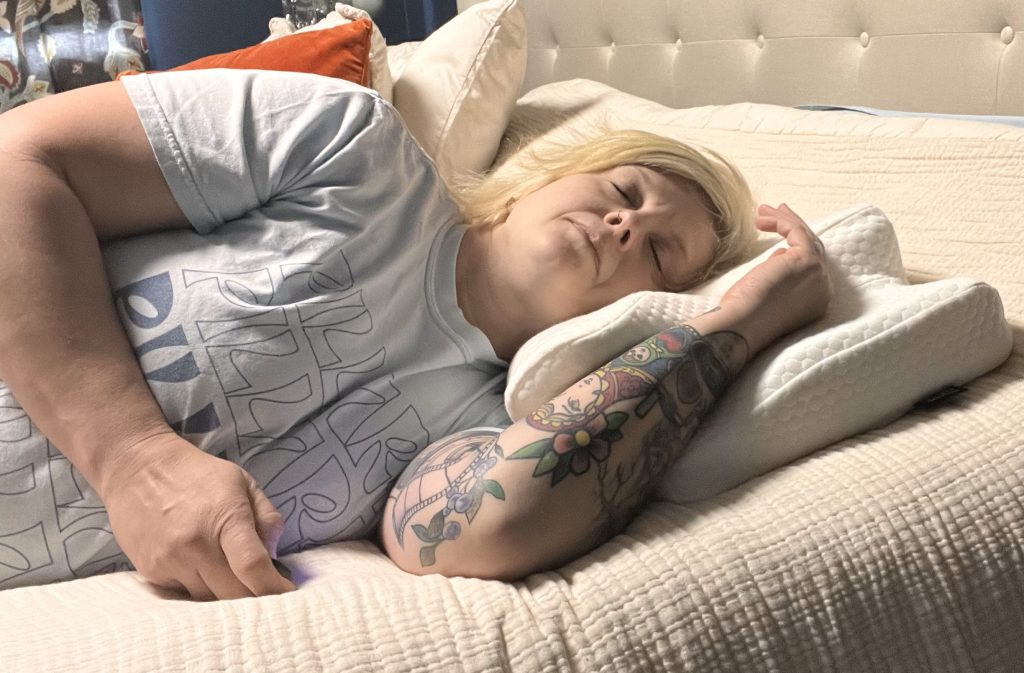People living with scoliosis, an abnormal curve in the spine, may find it challenging to get comfortable at night. This discomfort can lead to tossing and turning, or pain, which can make sleep feel all but impossible. Luckily, there are a few simple changes you can make that can help if you’re struggling to sleep with scoliosis.
In this article, we’ll talk about how scoliosis affects sleep and what you can do to improve your sleep. Most of these tips are simple lifestyle or sleep position changes that you can implement starting tonight. If you have scoliosis and have been struggling to get comfortable at night, we hope these adjustments have you sleeping more soundly in no time.
What Is Scoliosis?
Scoliosis is a condition that makes the spine (backbone) curve sideways, like the letter “S” or “C”, and it is most often diagnosed in adolescents1. While scoliosis can occur in people with conditions such as cerebral palsy and muscular dystrophy, the cause of most childhood scoliosis is not known.1
Most cases of scoliosis are mild, but some curves worsen as children grow. Severe scoliosis, however, can be disabling; an especially serious spinal curve can reduce the amount of space within the chest, making it difficult for the lungs to function properly.
Children who have mild scoliosis are monitored closely, usually with X-rays, to see if the curve is getting worse. In many cases, no treatment is necessary. Some children may need to wear a brace to stop the curve from worsening. Others may need surgery to straighten more serious curves.1
Scoliosis usually does not cause symptoms. A doctor or healthcare provider might find it during a child’s routine checkup, or the school nurse might notice it during a scoliosis check at school.1
You or your child or teen might also notice a shoulder, shoulder blade, hip, or breast that is higher than the other, or a shoulder blade that sticks out farther than the other.
When symptoms do occur, they can include back pain or trouble breathing – if the spine curves a lot, the lungs might not have room to work correctly, which can cause breathing problems. Scoliosis this severe usually starts when a child is younger than 10. However, the scoliosis is usually obvious before breathing problems happen.
Share Your Experience with Scoliosis
The Effect of Scoliosis on Sleep
From causing postural deviation and related muscle pain to structural back pain and/or radicular pain felt throughout the body, scoliosis can most certainly impact a person’s ability to get a good night’s sleep. Additionally, severe scoliosis can cause poor pulmonary function2, resulting in impaired breathing.
It is also important to acknowledge that anyone with scoliosis, regardless of how severe it is, could potentially struggle with sleep deprivation and daytime sleepiness.
5 Scoliosis Sleeping Tips
1. Get a Supportive Mattress
While a bad mattress won’t make scoliosis worse, you’re not doing your back any favors by lying on a bed that’s unsupportive. Further, it could make any pain you have more pronounced.
While soft and cushy mattresses are tempting, you’ll be better off with a medium-firm or firm mattress that allows your spine to remain in a well-supported, neutral position.
When you’re shopping for a new mattress, one of the things to look for is a mattress trial period. This sleep trial allows you to try the bed in your home for a limited amount of time to see if the bed is right for you. Many reputable companies offer a risk-free trial that’s 90 to 365 days long.
Check Out Our Guide: Top Rated Mattress for Scoliosis
If you’re not ready to buy a new bed, consider getting a mattress topper. As your bed gets older, it can start sagging and not provide the support you need. A mattress topper could give you additional lift for spinal alignment and may even extend your mattress’ life for another year or more.
2. Avoid Sleeping On Your Stomach
Stomach sleeping can be problematic even for individuals with healthy spines, so if you have scoliosis, we advise that you avoid sleeping on your stomach unless directed otherwise by your physician. Not only does this position often cause your head and neck to twist at unnatural angles, but it could also cause your spine to arch further out of alignment.
For people who can’t sleep in any other position, we usually recommend placing a pillow under the pelvis to better align the spine and prevent arching. If you have scoliosis, though, you’ll want to talk to your doctor first, since the curve of your spine will be unique.
Want to know more? Check out our guide for the best pillow for stomach sleepers.
3. Sleep On Your Back or Side
Many scoliosis patients find that sleeping on their backs3 is the best way to keep their spine neutral. However, you should avoid creating too much pressure on the lower back. Therefore, we recommend placing pillows or rolled-up towels under your shoulder blades and at the base of your spine.
Make sure your pillow isn’t too high or low. You don’t want to be propped up or sinking down into the mattress, and your spine should remain relatively flat and parallel to the bed.
Get More Info: How To Properly Sleep On Your Back and check out our expert-suggested Best Mattresses for Back Sleepers.
The advantage of side sleeping for patients with scoliosis is that this position is considered to be relatively healthy for spinal alignment. However, for those with a more pronounced curve on one side or the other, consider how your spine is shaped; if the biggest curve is on the right side of your body, then sleep on your left side, and vice versa. Side sleeping should also help with breathing issues caused by scoliosis.4
Find Out More: How to Properly Sleep on Your Side & Bed Beds for Side Sleepers
4. Use Pillows for Support
Pillows can be great for keeping your spine in proper alignment and help ensure your comfort all night long. You don’t want to sleep on a mountain of pillows that will throw your neck and back out of alignment. Instead, you want your spine and head to be as well aligned as possible.
For side sleepers, a pillow between the knees should help the spine stay in a neutral position and prevent twisting. Underneath the head, side sleepers can generally have thicker pillows, as the pillow will need to fill in the space from the neck to the end of the shoulder, but stomach and back sleepers typically need a cushion with a smaller profile to keep the spine as straight as possible.
Adjustable pillows are also a good option for people with scoliosis as they may experience numbness4 in the shoulder areas. With these pillows, you can remove the filling and easily change the height of the pillow, depending on your needs. Memory foam works well, too, as it contours to the shape of the head and neck and lessens pressure in these areas.
Consult with your doctor to make sure you’re using pillows to support you properly and not doing your spine any harm by putting it at an inappropriate angle. A lack of knowledge could lead to increased pain or discomfort.
View Our Guide: Best Pillow For Side Sleepers

5. Practice Good Sleep Hygiene
Sleep hygiene refers to your sleeping and bedroom habits. The best thing you can do to help get a restful night — other than having the perfect bed — is to practice habits that support healthy sleep.
The ideal bedroom should be between 60 and 67 degrees, as dark as possible, and noise-free. This might mean you need blackout curtains, an eye mask, or a white noise machine, depending on your living situation.
You should also develop a regular bedtime routine. This routine should help signal to your mind and body that it’s time to get ready to go to sleep. For example, drinking some chamomile tea, reading a book, meditating, journaling, or taking a bath – anything that is relaxing and doesn’t stress you out or elevate your heart rate. Avoid looking at screens for one hour before bed, as they emit blue light, which can delay sleep onset5.
A good bedtime routine also includes going to bed and waking up at the same time each day, establishing a consistent schedule.
Frequently Asked Questions
What are some natural ways to improve my scoliosis?
People with more severe cases of scoliosis are often seen wearing a back brace, which can be bulky and uncomfortable, thus making it harder to find a suitable sleep position. However, there are lighter-weight options on the market that look and feel more like a wrap than an inflexible brace. These allow for more natural movements and can be worn to bed.
Improving scoliosis through exercise6 is also an option as it can help strengthen the back and abdominal muscles surrounding the spine. In fact, when scoliosis is first detected, certain exercises may help prevent its progression.6
Practicing a healthy diet is beneficial as well. Focus on consuming foods that help increase bone density, promote muscle growth, and keep your body at a healthy weight, as being underweight or severely underweight increases the risk of developing or worsening scoliosis7. Some examples of good foods8 for scoliosis are fresh fruits and vegetables, lean proteins like fish, and foods rich in calcium, vitamins D and B, along with drinking lots of water throughout the day.
What are the best exercises for scoliosis?
The best exercises for scoliosis are ones that will strengthen the back and core. We recommend the following stretches to help stabilize the spine and provide pain relief:
- Exercise ball stretch: Lie on your side with the ball pressing into your side. Your feet and one hand will remain on the floor for stabilization. The hand that’s not on the floor will stretch forward over your head. Start on one side, hold for 20 seconds, and then switch. Repeat three times.*
- Foam roller towel stretch: Lie across a foam roller that’s covered with a towel. You’ll be in the same position as the first exercise that you did on the ball.*
- Partner stretch: Lie on your stomach with your torso, head, and neck above the floor. Rise into a plank position and have your partner support you to keep your back level.*
*Keep in mind these should be performed delicately and only if comfortable. We advise you to seek a professional’s advice before doing any strenuous movements.
Any tips for sleeping with a back brace?
First, you should be extra diligent about keeping the back brace dry. If moisture gets in, it could cause skin ulcers or a rash. Another helpful tip is to sleep on your back with a pillow under your legs, which will hopefully prevent the brace from digging into your body.
Finally, you may have discovered that it can be difficult getting in and out of bed with a back brace. To make things less challenging, instead of trying to sit up, roll to the side of the bed you wish to exit with your face down, push yourself up with your arms, and then gently move your legs off the bed. You should then be able to push yourself up and off the bed.
Is it good to sleep on the floor if you have scoliosis?
Sleeping on the floor is not recommended if you have scoliosis because it doesn’t allow your back to align properly. Instead, people with scoliosis should sleep on a mattress that is semi-firm and allows the curve of the spine to sink into the mattress while still being supported by a relatively firm surface.
Is sleeping without a pillow good for scoliosis?
If you have scoliosis, you should try to sleep on your side or back, which is typically more comfortable with a pillow. Without one, your head and neck may not get the necessary support, throwing your spine out of alignment. This misalignment could worsen your scoliosis symptoms, pain, and pressure. On top of that, you may want to consider adding a pillow under your lower back if you’re a back sleeper, or between your knees if you’re a side sleeper.
What can worsen scoliosis?
Most people with scoliosis do not have long-lasting problems. Some people may have back pain, but it is usually not serious. However, severe scoliosis that is not treated can damage the heart and lungs. If scoliosis is caused by a serious medical condition, that condition can cause problems, too.
Your doctor or healthcare provider will watch for problems and treat them if they happen.
All that said, scoliosis is progressive, which means it usually gets worse with age9, perhaps even if you are diligently avoiding all of these activities. However, it’s difficult to predict how much scoliosis will progress and after how many years. The condition is subject to unpredictable and quick changes, likely with both severe cases and smaller curves in the spine.9
This unpredictability is why getting an early diagnosis and seeking medical care early on is important.

Rachael Gilpin
Content Writer
About Author
Rachael is a content writer for Sleep Advisor who loves combining her enthusiasm for writing and wellness.
Back Sleeper
References:
- “5 Facts about Scoliosis Every Parent Should Know”. Johns Hopkins Medicine. Webpage accessed February 6, 2024.
- Johari, Joehaimey., et al. “Relationship between pulmonary function and degree of spinal deformity, location of apical vertebrae and age among adolescent idiopathic scoliosis patients”. Singapore Medical Journal. 2016.
- “How To Sleep With Scoliosis: Sleeping With Scoliosis”. Clear Scoliosis Institute. Webpage accessed July 15, 2023.
- “Adult Scoliosis”. University of Connecticut Health. Webpage accessed July 15, 2023.
- “Blue light has a dark side”. Harvard Health Publishing. 2020.
- “First Signs of Scoliosis and What to Do When they Appear to Stop Its Progression”. Align Clinic. 2020.
- Jeon, Kyoungkyu., Kim, Dong-il. “The Association between Low Body Weight and Scoliosis among Korean Elementary School Students”. International Journal of Environmental Research and Public Health. 2018.
- “Scoliosis Nutrition & Diet: What Foods Can You Eat?”. Clear Scoliosis Institute. Webpage accessed July 16, 2023.
- Irvine, Paul. “CAN SCOLIOSIS GET WORSE AS YOU AGE?”. UK Scoliosis Clinic. 2020.
